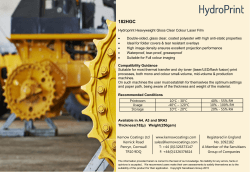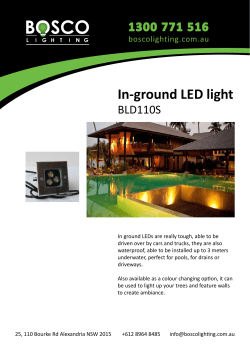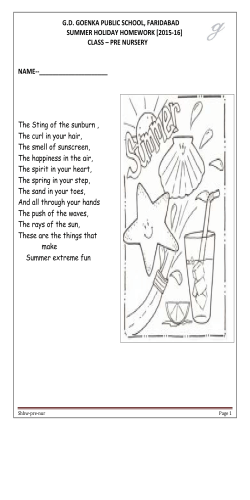
10 Reasons Paper-based 3D Printing is Better
10 Reasons Paper-based 3D Printing is Better 1 10 Reasons Paper-based 3D Printing is Better 10 Reasons Paper-based 3D Printing is Better 1 Introduction 3 D printers use a wide range of materials, including plastics, plaster powder, photopolymers, nylon, metal and even food products to produce physical 3D models and prototypes. Yet there’s another important 3D printer material to consider - paper. This isn’t origami or papier-mâché. This is advanced SDL (Selective Deposition Lamination) additive manufacturing technology that uses paper to build physical 3D models layer by layer. Paper offers several distinct advantages over other materials used by 3D printers. In this white paper, you’ll learn the benefits of paper, used as the build material in SDL 3D printers, to produce 3D printed models. Consider the 10 reasons paper is better than other materials for use in 3D printers: 1 Lowest Cost 3D printers are only useful when you have unlimited access to them. But high material costs can hinder, and even prevent, you from 3D printing. Paper is 10-20% the cost of any other 3D printer material. Common paper is not only a stably priced commodity, it is the lowest cost material in the 3D printing industry, just 10-20% the cost of competing technologies. The ongoing cost of using paper is one-fifth of any other 3D printing technology. In fact, the more models you make using paper, the lower your per-part cost. While most 3D and 2D printer manufacturers adhere to a traditional razor and blade business model, where they provide the hardware at a low cost and then profit from expensive replacement supplies, paper-based 3D printers are meant to intentionally provide lower operating costs in order Low cost of paper encourages an iterative design process, for better results. to encourage use of the technology for the iterative design process. The more iteration, the greater the innovation, all of which results in better designs. 10 Reasons Paper-based 3D Printing is Better 2 2 Photorealistic Colour Whether you’re a designer, engineer, architect, artist, animator, student, doctor, healthcare provider, entrepreneur or manufacturer – you live, think and create in full, living colour. More importantly, your clients, patients, students, audience and consumers do too. That’s why photorealistic, True Colour 3D printing capability is so important. Ink was intended for paper, which is the ideal canvas for bright, high-resolution colour. CMYK ink penetrates through each sheet of paper, resulting in high, 5760 x 1440 x 508 dpi, colour fidelity and photorealistic models. Ink was intended for paper, which is the ideal canvas for bright, high-resolution colour. Image courtesy Arius Technology. SDL paper-based 3D printers are also the only ones to include the global standard ICC (International Colour Consortium) colour map for unmatched colour accuracy. This WYSIWYG (what you see is what you get) colour capability means that the colour you see in your file on screen is true to the colour 3D printed on your model. The colour is consistent from part to part and on the undercuts and sidewalls of your models. 3D printing technologies using other materials either can’t print in colour, can only print in one colour at a time or can only provide a very limited palette and placement of colours on a model. Paper’s unique photorealistic colour capability enables infinitely more possibilities. Paper’s unique photorealistic colour 3D printing capability enables infinitely more possibilities – applications that aren’t possible with monochrome or blended-colour 3D printers, including colour coding, model labeling, lifelike or visually realistic modeling, heat/light and stress analyses or other attributes that 3D printers using other materials simply can’t deliver. It can be argued that SDL paper-based Paper-based 3D printers are the only ones to include the global standard ICC (International Colour Consortium) colour map for unmatched colour accuracy. 3D printers are the only true 3D printers, as they utilise a printhead and paper. 10 Reasons Paper-based 3D Printing is Better 3 3 Durable 3D printed models and prototypes are meant to be handled. Infinitely more information is communicated when you can feel and examine a 3D printed object in your hands or use it to perform functional testing for product development. Paper 3D printed models are tough and durable. It might surprise you to learn that 3D printed models made from paper are incredibly tough and durable – much more so than fragile powder-based models and ABS plastic, for example. Paper 3D printed models feel very much like wood. Unlike brittle 3D printed models made from powder, paper-based models can be used immediately following printing, without coating. If your application calls for tapping, drilling or using the model as a functional prototype, end product or use with water, paper models can be coated with a variety of suitable finishes, including Mcor SEAL or Mcor FLEX. After all, paper is 70% porous. If coated, they’ll last for many, many years. 4 Stable A sometimes overlooked characteristic of 3D printer materials is stability. Will the 3D printed model retain its precise shape and appearance? Unlike models made of plastics and photopolymers, paper models won’t warp or become soft with typical environmental temperature, light and time. This is critical for applications that rely on the accuracy of prototypes, such as product design, engineering, architecture, healthcare, as well as other applications where geometrical Paper models won’t warp or become soft with typical environmental temperature, light and time. accuracy is crucial. 10 Reasons Paper-based 3D Printing is Better 4 5 Safest There has been considerable press coverage and research recently about dangerous 3D printer particle emissions and serious injuries that can result when using many of consumerand hobby-class 3D printers, most of which use plastics Paper is safe, without toxic chemicals, exposed dangerous heat, light, or toxic emissions, and requiring no special disposal or venting. to produce 3D models. 3D printer and material safety is of utmost importance, particularly in educational settings. Paper is arguably the safest 3D printer material available. 3D printers using paper uniquely require no toxic chemicals in the printing process. In addition, no harmful particles are emitted during the process of 3D printing with paper, nor is the user exposed to dangerous heat or light. And rather than cutting and dissolving support structures or blowing and vacuuming away messy air born powders required with other materials following printing, completed 3D printed models made of paper can be quickly and easily removed from their surrounding paper with bare hands and common tweezers. 6 Most green and eco-friendly It’s important for each of us to be the best possible caretakers of the Earth. Developing or using advanced technology and environmental-friendliness don’t have to be mutually exclusive. Users of paper-based 3D printers benefit from professionalquality 3D printing technology while, at the same time, remaining green and eco-friendly. Paper, water-based glue and waterbased ink are the only materials used in the process of 3D Paper, water-based glue and waterbased ink are all completely non-toxic and recyclable. printing with paper. These materials are completely non-toxic and recyclable. Even the models themselves are recyclable. Pre-printed paper can be used when available and multiple models can be built simultaneously – the same or different models – reducing the amount of material to be recycled at the end of the process. 10 Reasons Paper-based 3D Printing is Better 5 7 Professional Quality Paper-based models made using SDL technology are strictly professional-class. With a resolution of 12μ, 12μ, 100μ (0.0004 in, 0.0004 in, 0.004 in), they are highly accurate with fine detail and able to include hollows, moving parts and photorealistic Paper models are cut to a precision of 0.0004in (0.012mm) and a dimensional accuracy of 0.004in (0.1mm). colour. Paper models are also uniquely tactile; not rough and heavy like powder-based models. 8 Office and Classroom Friendly It’s important for 3D printers to be well suited for professional office and classroom environments if that is where they are meant to be used. But being office and classroom friendly means more than just the small physical size of the machine. The 3D printer and its materials must also be safe, easy to operate, clean and require no special facility requirements. As mentioned earlier, paper-based 3D printers are the safest in the industry and designed to be as easy to use as a document printer. And because paper is used together with other nontoxic materials, no special ventilation or disposal systems are needed, just an ordinary recycle bin like those already in offices and classrooms around the world. 3D printers that use paper Paper-based 3D printing is safe, easy to use, clean and has no special facility requirements.. plug into standard electrical outlets and are quiet and clean, without the messy powders or melting plastics used by many other 3D printers. All of which makes paper-based 3D printers ideal for office and classroom environments. 9 Versatile No single 3D printer available today can meet every application need. However, some 3D printers, by virtue of the material they use, are far more versatile than others. Paper’s cost, colour and safety advantages enable its use across a wide variety of applications and settings. Paper, and its distinct advantages over other materials in affordability, colour, safety, office- and eco-friendliness and its ability to be sterilised enables it to be used across a wide variety of different applications, physical environments and academic departments. 10 Reasons Paper-based 3D Printing is Better 6 For example, paper is well suited for professional applications and academic departments, including industrial design, marketing, architecture, medicine, fine and dramatic arts, cultural heritage, entertainment, consumer and GIS. And, SDL 3D printers that use paper can easily be placed in a number of settings, from a classroom or a surgeon’s office to a manufacturer’s rapid prototyping lab, an architect’s office or retail storefront. 10 Ubiquitous Closely related to the cost of 3D printer materials is how widely available they are for purchase. Paper used in SDL 3D printers is readily available and purchased for very low cost. Paper is readily available and can be purchased affordably. Conclusion Y ou would never have just one tool in your toolbox. Rather, you likely have a number of different tools in your toolbox to meet your varied repair and build needs. 3D printing is no different. In many situations, paper-based 3D printing is a perfect complement to other technologies. For example, if you are an educator, students must be introduced to various, safe technologies in order to provide them with suitable experience and better prepare them for their careers. Similarly, it’s essential for service bureaus to have a variety of technologies to suit the unpredictable and wide variety of customer applications that come their way. Manufacturers can use low-cost, full colour paper-based 3D printers to create inexpensive, photorealistic, professional-quality models for proof of concept, sales and marketing purposes and then another, much more expensive material at the point in the process when the product must be functionally tested or actually produced. Yes, the days of having just one type of 3D printing technology in your toolbox have passed, but it’s equally important to use the right 3D printer material for the right application. You wouldn’t use a sledgehammer to hang a picture frame. Similarly, expensive monochrome and limited-colour materials shouldn’t be used for concept purposes because they inhibit the effectiveness of communication and limit design iterations. You don’t need to spend excessive budget to produce a 3D model out plastics, powders, nylons, metals and the like in instances where paper-based models will suit just perfectly – and often even more effectively than more expensive materials. 10 Reasons Paper-based 3D Printing is Better 7 About Mcor Technologies Ltd M cor Technologies Ltd is an innovative manufacturer of the world’s most affordable, full-colour and eco-friendly 3D printers. They are the only 3D printers to use ordinary business A4 and letter paper as the build material, a choice that renders durable, stable and tactile models. Established in 2004 with a talented team of specialists in the area of 3D printing hardware and software, Mcor’s vision is to make 3D printing more accessible to everyone. The company operates internationally from offices in Ireland, the UK, America and APAC. www.mcortechnologies.com © 2015 Mcor Technologies Ltd. All rights reserved. Mcor IRIS is a trademark and Mcor Technologies Ltd is a registered trademark of Mcor Technologies Ltd. All other company and product names are pending trademarks or registered trademarks of their respective holders. PAPER-WP-28012015
© Copyright 2026









